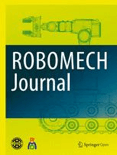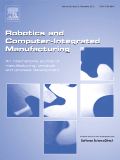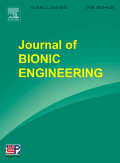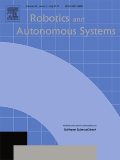
ADVANCED ROBOTICS
Scope & Guideline
Driving Excellence in Robotic Solutions
Introduction
Aims and Scopes
- Robotic Perception and Sensing:
Research in this area emphasizes the development of advanced sensors and perception algorithms that enable robots to understand and interact with their environments effectively. - Human-Robot Interaction (HRI):
This scope focuses on improving the ways robots communicate and collaborate with humans, addressing emotional, social, and cognitive aspects of interaction. - Control Systems and Robotics Algorithms:
Publications often explore novel control techniques, such as reinforcement learning and model predictive control, aimed at enhancing robot autonomy and adaptability. - Robotic Applications in Healthcare and Rehabilitation:
The journal features studies on the design and implementation of robots for medical applications, including rehabilitation robots and assistive devices for the elderly and disabled. - Multi-Robot Systems and Coordination:
Research in this area investigates collaborative behaviors among multiple robots, emphasizing swarm intelligence and distributed control strategies. - Soft Robotics and Bio-Inspired Design:
The journal includes innovative designs inspired by biological systems, focusing on soft robotics and adaptable mechanisms that improve interaction with complex environments. - Robotics in Agriculture and Industry:
Publications address the application of robotics in agricultural settings and industrial automation, highlighting efficiency improvements and new technological integrations.
Trending and Emerging
- Artificial Intelligence in Robotics:
An increasing number of publications explore the integration of AI techniques, such as machine learning and deep learning, to enhance robotic capabilities, particularly in perception and decision-making. - Socially Assistive Robotics:
There is a growing interest in developing robots that can assist in social contexts, such as healthcare and education, emphasizing emotional intelligence and user adaptability. - Collaborative Robots (Cobots):
Research on collaborative robots that work alongside humans in various environments, such as manufacturing and healthcare, is trending, highlighting safety and efficiency. - Robotic Rehabilitation Technologies:
The field of rehabilitation robotics is expanding, with a focus on developing systems that support physical therapy and enhance patient recovery through personalized assistance. - Robotics for Environmental Monitoring and Sustainability:
Emerging themes include the use of robotics for environmental applications, such as monitoring ecosystems and aiding in disaster response, reflecting a societal push towards sustainability. - Teleoperation and Remote Robotics:
The rise of teleoperation technologies, particularly in remote surgery and exploration, showcases advancements in haptic feedback and real-time control.
Declining or Waning
- Traditional Industrial Robotics:
Research focused exclusively on traditional industrial robots has decreased, likely due to the growing interest in more versatile and adaptive robotic systems. - Basic Robotic Mechanisms:
There is a noticeable reduction in papers solely discussing basic mechanical designs, as more emphasis is placed on intelligent systems and advanced functionalities. - Single-Task Robots:
The focus on robots designed for single, specific tasks is diminishing, as the trend shifts towards multi-functional robots capable of performing various roles. - Robotic Simulation without Real-World Application:
Papers that focus primarily on theoretical simulation models without integration into real-world scenarios have become less frequent, indicating a preference for applied research.
Similar Journals

Annual Review of Control Robotics and Autonomous Systems
Empowering Innovation in Autonomous TechnologiesAnnual Review of Control Robotics and Autonomous Systems, published by ANNUAL REVIEWS, is a premier, peer-reviewed journal dedicated to advancing the field of control, robotics, and autonomous systems. With its E-ISSN of 2573-5144, the journal is recognized for its high-caliber contributions, evidenced by its Q1 ranking in key categories, including Artificial Intelligence, Control and Systems Engineering, and Human-Computer Interaction. Spanning converged years from 2018 to 2024, it serves as an essential resource for researchers, professionals, and students who seek to stay abreast of the latest developments and methodologies impacting these rapidly evolving fields. The journal does not currently offer Open Access options, which enables it to maintain stringent quality control while ensuring that every issue is packed with scholarly articles that meet the highest academic standards. With a focus on interdisciplinary approaches and cutting-edge technologies, the Annual Review of Control Robotics and Autonomous Systems is poised as a critical voice for scholarly discourse, fostering innovation and collaboration in tackling complex challenges of the modern world.

JOURNAL OF INTELLIGENT & ROBOTIC SYSTEMS
Pioneering Research in Robotics and AIJOURNAL OF INTELLIGENT & ROBOTIC SYSTEMS, published by Springer, is a premier interdisciplinary journal that focuses on the rapidly evolving fields of artificial intelligence, robotics, and their applications across various engineering domains. With an impressive impact factor and ranked in the Q1 and Q2 quartiles of multiple relevant categories—including Electrical and Electronic Engineering, Control and Systems Engineering, and Mechanical Engineering—this journal is essential for researchers, industry professionals, and graduate students seeking to stay at the forefront of innovation in intelligent systems. The journal publishes high-quality research articles, reviews, and technical notes that contribute to advancing theory, practice, and the integration of intelligent robotic systems better suited to meet contemporary challenges. Founded in 1988, and with a robust indexing in Scopus, the journal continues to foster scholarly discourse and serves as a critical resource for those passionate about the future of intelligent technologies, despite not currently providing open access options.

Industrial Robot-The International Journal of Robotics Research and Application
Elevating Standards in Robotics Research and ApplicationIndustrial Robot-The International Journal of Robotics Research and Application is a premier academic journal published by Emerald Group Publishing Ltd in the United Kingdom. Since its inception in 1973, the journal has established itself as a critical resource for the advancement of knowledge in the fields of robotics and automation. With an impressive Q2 ranking across several categories, including Computer Science Applications, Control and Systems Engineering, and Industrial and Manufacturing Engineering, it places itself among the top-tier journals in its domain. The journal aims to disseminate high-quality research that addresses contemporary challenges and innovations in robotics, thereby supporting both academic inquiry and practical applications in industry. Researchers, professionals, and students are encouraged to contribute to its mission, as it remains vital for those seeking to engage with the ever-evolving landscape of robotic technologies.

International Journal of Automation and Computing
Pioneering Discoveries in Computing and SimulationInternational Journal of Automation and Computing, published by SPRINGERNATURE, is a premier academic journal dedicated to advancing knowledge in the fields of applied mathematics, computer science applications, control and systems engineering, and modeling and simulation. With an impressive impact factor and consistently ranked in the Q1 Quartile for its respective categories in 2023, the journal is recognized for its high-quality research and contributions to the automation and computing sectors. This journal provides open access to its articles, promoting the dissemination of innovative ideas and methodologies across a global audience. Based in China but serving an international community, the journal is key for researchers, professionals, and students looking to stay at the forefront of automation and computing technologies. Its rigorous peer-review process ensures that published works meet the highest scientific standards, making it an essential resource for those seeking to deepen their understanding and engage in cutting-edge research.

INTERNATIONAL JOURNAL OF ROBOTICS & AUTOMATION
Advancing the Future of Robotics and Automation.International Journal of Robotics & Automation is a premier academic journal published by ACTA PRESS, dedicated to advancing knowledge and applications in the dynamic fields of robotics, automation, and related engineering disciplines. With a history spanning from 1995 to 2024, this journal serves as a crucial platform for the dissemination of innovative research, offering valuable insights across various categories, including Artificial Intelligence, Control and Systems Engineering, and Mechanical Engineering. Although currently not open access, its rigorous peer-reviewed articles hold significance for researchers, professionals, and students alike, providing a solid foundation for advancements in technology and engineering methodologies. The journal's rankings in Scopus reflect its growing impact, particularly in niche areas of Modeling and Simulation and Software, highlighting the critical need for cutting-edge research and discussion in these developing fields. As the landscape of robotics and automation continues to evolve, this journal remains an essential resource for those seeking to contribute to and engage with the forefront of scholarly research.

ROBOMECH Journal
Unleashing Knowledge in Robotics and Mechanical EngineeringROBOMECH Journal, published by SpringerNature, is a prominent open-access journal dedicated to the fields of robotics, mechanical engineering, and artificial intelligence. Established in 2014, the journal has quickly established itself as a vital platform for disseminating innovative research in control and optimization, instrumentation, and modeling and simulation, earning a commendable Q2 ranking in Mechanical Engineering and multiple Q3 rankings across other relevant fields in 2023. With a commitment to facilitating accessible knowledge sharing, ROBOMECH Journal promotes cutting-edge research that drives advancements in both theoretical frameworks and practical applications within the robotics community. Scholars, engineers, and professionals seeking to contribute to or stay informed about the latest developments in these dynamic fields will find the journal's rich array of articles invaluable. With its open-access model, all published research is freely available, ensuring wide dissemination and increased visibility for authors, thus fostering collaboration and innovation across disciplines.

ROBOTICS AND COMPUTER-INTEGRATED MANUFACTURING
Driving Excellence in Robotics and Manufacturing ResearchROBOTICS AND COMPUTER-INTEGRATED MANUFACTURING is a prestigious, peer-reviewed journal published by PERGAMON-ELSEVIER SCIENCE LTD. With an impressive impact factor and rankings placing it in the Q1 quartile across multiple categories, including Computer Science Applications, Control and Systems Engineering, and Industrial and Manufacturing Engineering, this journal is a leading source for cutting-edge research in its field. Since its inception in 1984 and covering a broad range of topics until 2025, it provides an essential platform for scholars and practitioners aiming to explore innovative technologies and methodologies that integrate robotics and computing in manufacturing processes. Although it does not offer an Open Access option, its rigorous editorial standards and high visibility in academic circles make it a vital resource for anyone seeking to contribute to or stay informed about advancements in these dynamic fields. As an authoritative voice in the landscape of industrial research, ROBOTICS AND COMPUTER-INTEGRATED MANUFACTURING inspires engaging discussions and collaborations among researchers, professionals, and students alike, driving forward the evolution of smart manufacturing solutions.

Journal of Bionic Engineering
Innovating Solutions through Biomimetic ResearchJournal of Bionic Engineering is a prominent publication in the field of bioengineering, biophysics, and biotechnology, published by Springer Singapore Pte Ltd. Since its inception in 2006, this journal has provided a vital platform for researchers and professionals to disseminate groundbreaking work and innovative approaches in the rapidly evolving realm of bionic systems and biomimetic technologies. With an impact factor that reflects its quality and relevance, it is currently positioned in the Q2 quartile across several key categories, underscoring its substantial influence in academia. The journal is indexed in Scopus, where it ranks competitively in biochemistry, genetics, molecular biology, and chemical engineering, showcasing its appeal to a broad spectrum of scientific disciplines. Although it does not offer open access, it remains a critical resource for those engaged in advanced research and development, fostering connections among scholars, practitioners, and educators dedicated to pushing the boundaries of bionic engineering. As the journal continues to converge from 2006 to 2024, it aims to uphold its mission of promoting interdisciplinary research that contributes to the understanding and application of bionic technologies in solving real-world challenges.

Cyborg and Bionic Systems
Elevating Understanding of Cyborgs and BionicsCyborg and Bionic Systems, published by the American Association for the Advancement of Science, stands as a pivotal open access journal that has enriched the academic landscape since its inception in 2020. With an E-ISSN of 2692-7632, this journal focuses on interdisciplinary research that converges on advances in Artificial Intelligence, Biomedical Engineering, Human-Computer Interaction, and Mechanical Engineering. Notably, the journal has attained impressive rankings, securing Q1 status across these categories and exhibiting a commendable Scopus ranking with percentile standouts in each discipline, thus establishing its influence and relevance in the scientific community. Based in Washington, DC, this journal provides a platform for innovative ideas and findings that aim to enhance our understanding of cyborg systems and bionic devices. The open access model ensures that groundbreaking research is readily available to researchers, professionals, and students alike, fostering collaboration and knowledge dissemination within these rapidly evolving fields.

ROBOTICS AND AUTONOMOUS SYSTEMS
Connecting Minds to Drive Robotic Innovations.ROBOTICS AND AUTONOMOUS SYSTEMS, published by Elsevier, is a leading journal in the fields of robotics and automation, providing a platform for the dissemination of high-quality, peer-reviewed research. With an impressive impact factor and a prestigious reputation, this journal is classified in the Q1 category for major fields including Computer Science Applications, Control and Systems Engineering, Mathematics, and Software as of 2023. The journal boasts an extensive archive dating back to 1988, reflecting the evolution of the discipline and fostering innovative research discussions that are crucial for advancements in autonomous technologies. Researchers, professionals, and students are encouraged to contribute to and benefit from the ongoing dialogue within these dynamic fields. Accessible through various academic resources, ROBOTICS AND AUTONOMOUS SYSTEMS stands as a pivotal information source for those dedicated to exploring the frontiers of intelligent systems.